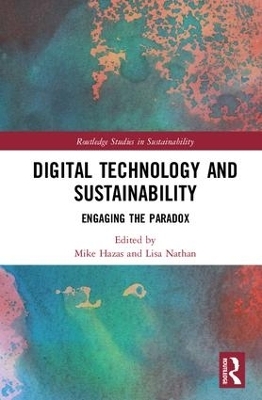
Digital Technology and Sustainability
Routledge (Verlag)
978-1-138-20588-8 (ISBN)
Contemporary digital technologies are hailed by tech companies, governments and academics as leading-edge solutions to the challenges of environmental sustainability; smarter homes, more persuasive technologies, and a robust Internet of Things hold the promise for creating a greener world. Yet, deployments of interactive technologies for such purposes often lead to a paradox: they algorithmically "optimize" heating and lighting of houses without regard to the dynamics of daily life in the home; they can collect and display data that allow us to reflect on energy and emissions, yet the same information can cause us to raise our expectations for comfort and convenience; they might allow us to share best practice for sustainable living through social networking and online communities, yet these same systems further our participation in consumerism and contribute to an ever-greater volume of electronic waste.By acknowledging these paradoxes, this book represents a significant critical inquiry into digital technology’s longer-term impact on ideals of sustainability.
Written by an interdisciplinary team of contributors this book will be of great interest to students and scholars of human computer interaction and environmental studies.
Mike Hazas is Senior Lecturer in the School of Computing and Communications, Lancaster University. Lisa P. Nathan is Assistant Professor at the School of Library Archival and Information Studies, University of British Columbia.
Photo Essay 1: Selfie Time
Eli Blevis
Introduction: Digital Technology and Sustainability: Engaging the paradox
Mike Hazas and Lisa P. Nathan
Photo Essay 2: Artifice and Nature
Eli Blevis
Part 1: Assessing the Field
Chapter 1: Three Principles of Sustainable Interaction Design, Revisited
David Roedl, William Odom and Eli Blevis
Chapter 2: Towards a Social Practice Theory Perspective on Sustainable HCI Research and Design
Adrian K. Clear and Rob Comber
Chapter 3: A Conversation Between Two Sustainable HCI Researchers: The role of HCI in a Positive Socio-Ecological Transformation
Samuel Mann and Oliver Bates
Response 1a: Sustainable HCI: From Individual to System
Chris Preist
Response 1b: Sustainability within HCI within Society: Improvisations, Interconnections and Imaginations
Janine Morley
Photo Essay 3: Rooftop Garden
Eli Blevis
Part 2: Addressing Limits
Chapter 4: Every Little Bit Makes Little Difference: The Paradox within SHCI
Somya Joshi and Tessy Cerratto Pargman
Chapter 5: Developing a political economy perspective for sustainable HCI
Bonnie Nardi and Hamid Ekbia
Chapter 6: Software Engineering for Sustainability: Tools for Sustainability Analysis
Birgit Penzenstadler and Colin C. Venters
Response 2: Challenging the Scope?
Enrico Constanza
Photo Essay 4: Classroom Exercise
Eli Blevis
PART 3: Ways To Engage With Others
Chapter 7: Communicating SHCI Research to Practitioners and Stakeholders
Christian Remy and Elaine M. Huang
Chapter 8: Negotiating and Engaging with Environmental Public Policy at Different Scales
Vanessa Thomas
Chapter 9: On the Inherent Contradictions of Teaching Sustainability at a Technical University
Elina Eriksson and Daniel Pargman
Chapter 10: Participation in Design for Sustainability
Janet Davis and Sandra Burri Gram-Hansen
Response 3a: Connected and Complicit
Mél Hogan
Response 3b: From Participatory Design to Participatory Governance through Sustainable HCI Rónán Kennedy
Photo Essay 5: Airstream
Eli Blevis
Part 4: Inspiring Futures
Chapter 11: A Sustainable Place: Everyday Designers as Place Makers
Audrey Desjardins, Xiaolan Wang, and Ron Wakkary
Chapter 12: Interaction Design for Sustainability Futures: Towards Worldmaking Interactions
Roy Bendor
Chapter 13: Think Local Act Local: The Case of Burning Man
a.m. tsaasan and Bonnie Nardi
Response 4: Sustainability Futures and the Future of Sustainable HCI
Yolande Strengers
Photo Essay 6: Locked Gate
Eli Blevis
Epilogue:
Mike Hazas and Lisa P. Nathan
| Erscheinungsdatum | 15.01.2018 |
|---|---|
| Reihe/Serie | Routledge Studies in Sustainability |
| Zusatzinfo | 1 Tables, black and white; 5 Line drawings, black and white; 16 Halftones, black and white; 21 Illustrations, black and white |
| Verlagsort | London |
| Sprache | englisch |
| Maße | 156 x 234 mm |
| Gewicht | 522 g |
| Themenwelt | Informatik ► Software Entwicklung ► User Interfaces (HCI) |
| Naturwissenschaften ► Biologie ► Ökologie / Naturschutz | |
| Technik ► Umwelttechnik / Biotechnologie | |
| ISBN-10 | 1-138-20588-5 / 1138205885 |
| ISBN-13 | 978-1-138-20588-8 / 9781138205888 |
| Zustand | Neuware |
| Haben Sie eine Frage zum Produkt? |
aus dem Bereich


